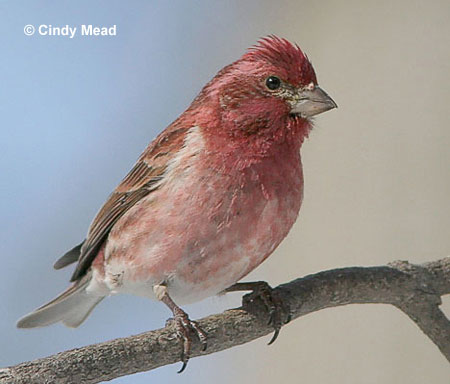
The birds of New Hampshire include 425 species of thrushes, warblers, and raptors! In New Hampshire, Hermit Thrushes sing from cool woodlands, and beautiful Black-throated Blue Warblers flit in the hemlocks.
New Hampshire is a peaceful and beautiful place with an abundance of birds! How many bird species have you seen in New Hampshire? We bet you’ve seen lots but how many could you identify?
This list of the top 27 most common backyard and wild New Hampshire birds will help!
On this page
Most Common Birds of New Hampshire (Top 27)
According to eBird data from 2021 to 2023, our list shows the 27 most common birds of New Hampshire.
To help recognize these birds of New Hampshire, we included information about behavior and key field marks (remember that the species on the bottom of the list are common birds too!).
Black-capped Chickadee
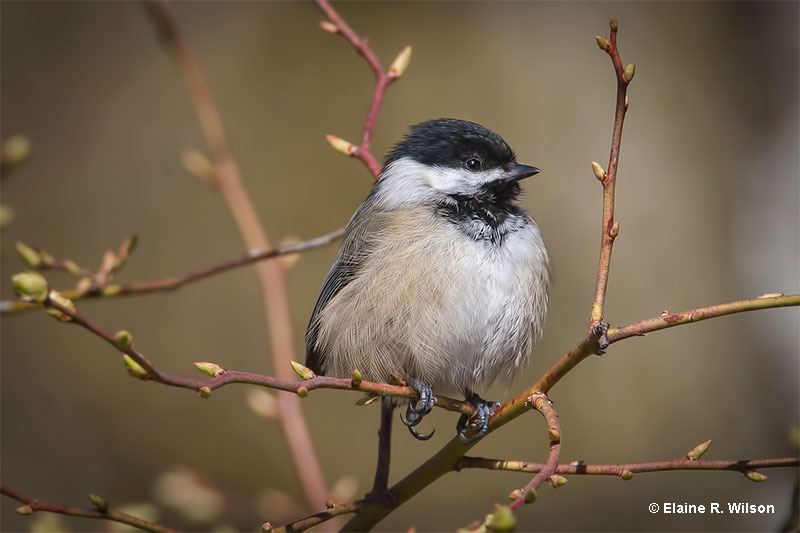
Scientific name: Poecile atricapilla
Length: 5.25 inches
Weight: .39 ounces
Wingspan: 8 inches
Song: “see bee, see bee”
Black-capped Chickadees are small grayish birds with a black cap, black throat, and a stubby black beak. Both sexes look alike and have a white face, white edging to the feathers in their wings, and some buff on their underparts.
These cute little birds feed on caterpillars, insects, spiders, seeds, and fruit. They are regular visitors to feeders but also forage on bark, twigs, and in foliage. When foraging, they often hang upside down from twigs and usually occur in small flocks.
This species makes a small, soft nest out of moss and deer hair. It builds its nest in tree cavities and can also use nest boxes.
Black-capped Chickadees live in a variety of wooded habitats and can also occur in gardens. They are year-round residents in parts of Alaska, Canada, and the northern USA south to Oregon, northern New Mexico, northern Ohio, and the Appalachian Mountains to North Carolina.
Key Identifications:
- Small, cute, grayish birds with a black cap, white face, and a black throat.
- Forages for insects, spiders, seeds, and fruit in wooded habitats. Also visits feeders.
- Nests in tree cavities and nest boxes.
- This little bird is quite vocal and often says its name, “chick-a-deedeedeedeedee”. They also make other chattering calls and sing a whistled song, “see bee, see bee”.
The Black-capped Chickadee is a small, acrobatic bird with a black cap, white face, and a black throat. It is also a state bird of Massachusetts. They usually forage in flocks with other chickadees and other small birds, and often visit feeders. This species hides dozens of seeds and other bits of food for the winter, and recalls where each of these food items are hidden.
Blue Jay
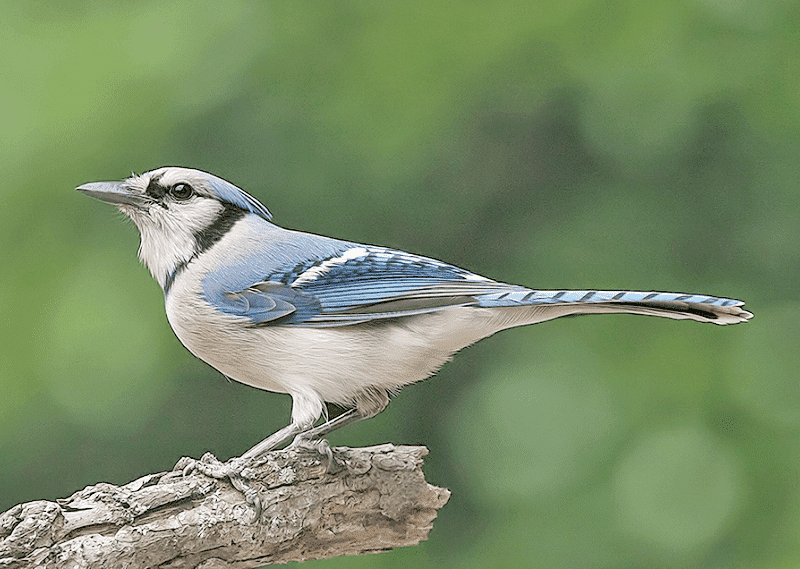
Photograph © Alan Wilson.
Scientific name: Cyanocitta cristata
Length: 11 inches
Weight: 3 ounces
Wingspan: 16 inches
Song: “Nyeah! Nyeah! Nyeah!”
The Blue Jay is a fairly large, crested bird with a straight black bill. Both sexes look alike and are blue above and gray and white below. They also have some small black lines on their faces and a narrow black necklace that goes up to the side of their face and crest.
Blue Jays also have some white markings and black barring in their wings and on their tail. Young birds look like adults but are duller blue.
They make messy cup nests at various heights in a variety of trees.
These social and intelligent birds feed on acorns, nuts, insects, and other small creatures. Like other members of the jay and crow family, they eat the eggs and nestlings of other birds.
The Blue Jay is a common bird of woodlands, forest, and towns east of the Rocky Mountains in the USA and central and southern Canada.
Key Identifications:
- Crested, fairly large bird with bright blue above and gray below.
- Feeds in trees and at feeders. Eats acorns, nuts, insects and many other food items.
- Makes a messy cup nest of sticks in a tree.
- Very vocal. In flight, Blue Jays often call as they swoop through the trees. They make a variety of sounds and mimic some other birds. Common calls include a nasal and complaining “Nyeah! Nyeah! Nyeah!” and various whistled calls.
The Blue Jay is a common, intelligent, and noisy bird. They make their presence known with their loud calls and can visit feeders. Ironically, when communicating with each other at close quarters, this species makes much softer and quieter calls. It’s almost as if they are talking with each other!
American Goldfinch
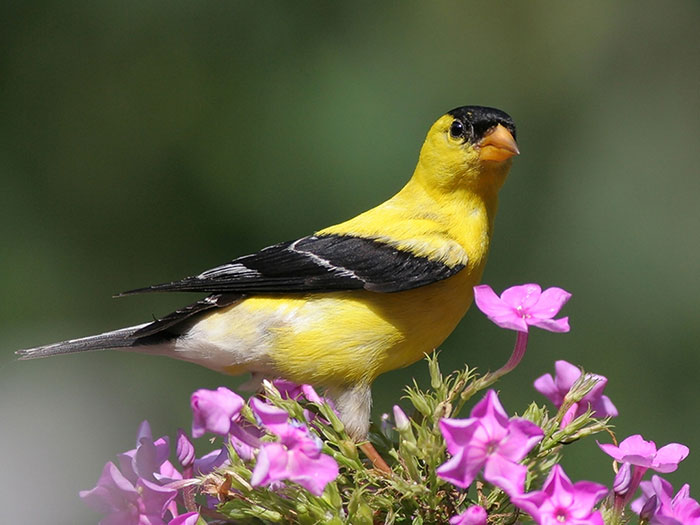
Scientific name: Carduelis tristis
Length: 5 inches
Weight: .46 ounces
Wingspan: 9 inches
Song: “swit sweet, sipsipsipchichisweetsweet”
The American Goldfinch is a small, sparrow-sized finch with a black and white, slightly forked tail, pale rump, and white undertail. In summer, males are bright lemon yellow with a small black cap, pale beak, and have some white markings on long black wings.
Females and wintering birds have two pale wings bars and have plain gray, buff, and yellowish plumage. This species often occurs in small flocks and has bounding flight.
American Goldfinches feed on seeds. They forage by picking them from grass, thistle, other low plants, Alders, and other trees. Goldfinches are also frequent visitors to bird feeders.
The American Goldfinch uses plant matter and other soft materials to build a small, tightly woven cup nest high in a shrub or a low tree.
American Goldfinches are summer residents in southern Canada, California, and the northern half of the USA, and winter in most of the USA and parts of Mexico.
Key Identifications:
- Small, bright yellow finch with a black cap, wings and tail (summer male), female and winter males are plain brown, buff, and yellowish birds with two pale wing bars.
- Feeds on seeds in low plants, trees, and at feeders.
- Makes a tightly woven cup nest high in a shrub or low tree.
- Often gives a “per chickory” call in flight and sings a short, trilled song, “swit sweet, sipsipsipchichisweetsweet”.
American Goldfinches are small, common finches that frequent weedy and brushy fields, second growth, parks, and backyards. Outside of the breeding season, they occur in small flocks and often visit feeders. Brown-headed Cowbirds that hatch in American Goldfinch nests die after a few days because they can’t survive on a diet of seeds.
American Crow

Scientific name: Corvus brachyrhynchos
Length: 17.5 inches
Weight: 1 pound
Wingspan: 39 inches
Song: “Caw! Caw!”
The American Crow is a big, all black bird with a strong, stout bill. In certain lighting, it can have metallic purple and blue iridescence.
Both sexes look the same and have some feathering on their beaks, long, broad wings, and a broad tail.
American Crows have direct flight with strong, steady wing beats. Crows are very social and intelligent birds that are usually seen in flocks. They forage together on the ground or in trees and eat just about anything they can find.
Some of their more regular foods include carrion, fruit, nuts, seeds, insects, and small animals. Like most jays and crow species, they also eat the eggs and nestlings of other bird species.
This species builds bulky stick nests high in trees and lives in most habitats except for high mountains and arid zones.
The American Crow occurs in southern Alaska and much of Canada and the USA.
Key Identifications:
- Big, all black bird with long, broad wing and a broad tail.
- Forages for carrion, fruit, seeds, insects, and small animals.
- Builds a bulky stick nest high in a tree.
- American Crows are very vocal birds. They can make several calls but their most common one is, “Caw! Caw! Caw!”.
The American Crow is a common, large black bird that frequently calls, “Caw! Caw! Caw!”. It usually occurs in flocks and lives in all sorts of places, even urban zones. These birds are very smart and have funerals or wakes! When a crow dies, other crows mark the occasion by gathering together and loudly calling.
Tufted Titmouse
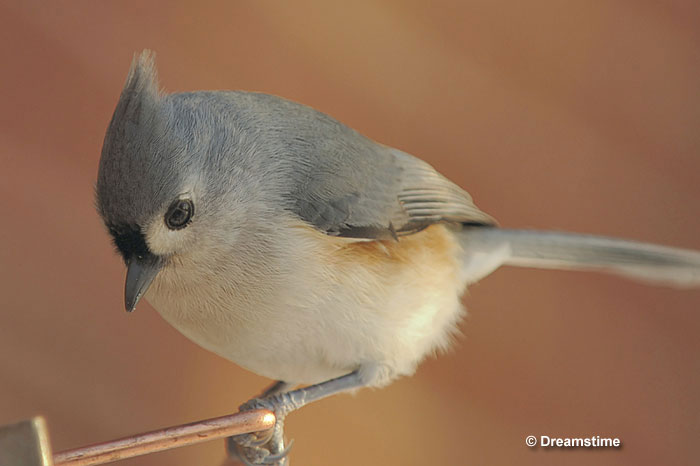
Scientific name: Baeolophus bicolor
Length: 6.5 inches
Weight: .75 ounces
Wingspan: 9.75 inches
Song: “peter peter peter”
The Tufted Titmouse is a small, crested, blue-gray bird with a white face. Males and females look the same and have a small black mark above their stubby black beak. They also have pale underparts with peach-orange flanks.
These cute little birds occur in small groups that forage for insects and seeds in parks and woodlands. They move through the trees and use their bills to pick food from leaves, bark, and branches. Tufted Titmouse are also regular visitors to bird feeders.
These small birds nest in woodpecker holes and other cavities in dead trees, and can also use nest boxes.
We find the Tufted Titmouse in hardwood forests and forested urban areas. They are often heard before they are seen, and flock with other small birds. When they see a predator, they are some of the first birds to harass it.
The Tufted Titmouse occurs in the eastern USA and some parts of southeastern Canada.
Key Identifications:
- Small, crested blue-gray bird with pale underparts and a white face.
- Feeds on seeds and insects and visits feeders.
- Nests in tree cavities and nest boxes.
- The Tufted Titmouse is a very vocal bird. It gives constant whistled calls over and over, “peter peter peter“.
The Tufted Titmouse is an easily recognized bird that lives in parks, gardens, and woodlands. It occurs in small flocks, often visits feeders, and needs dead trees or nest boxes to breed. This species lines its nest with mammal hair including fur from Raccoons, Opossums, and other animals.
American Robin
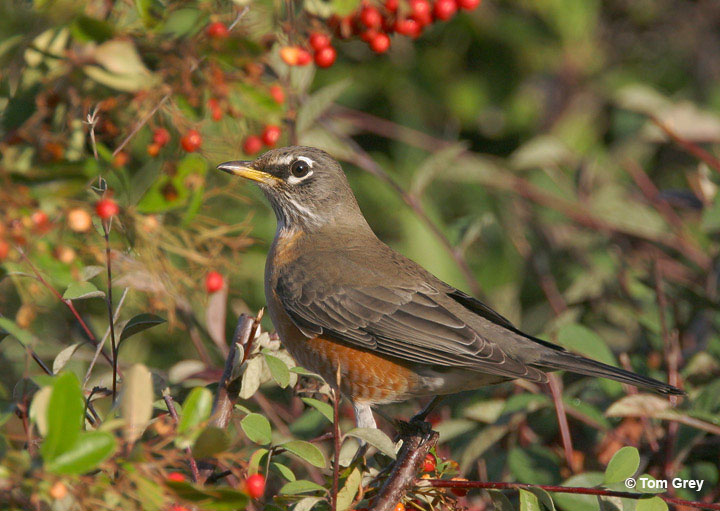
Scientific name: Turdus migratorius
Length: 10 inches
Weight: 2.7 ounces
Wingspan: 17 inches
Song: “cheery, cheery, cheery, cheery, cheer, cheer”
The American Robin is a familiar and common thrush that is dark gray above and brick red below. It also has an orange-yellow bill, a blackish head with white markings around the eyes and on the throat, and a white belly.
Both sexes of this thrush species are similar but males are darker above and more reddish on the underparts. Young American Robins have more white marks on their faces and spotting on orange underparts.
In flight, this common thrush in also shows white corners in its outer tail feathers.
American Robins forage on the ground for worms, insects, snails, and other small creatures. In winter, these common birds flock together and perch in trees and bushes to eat berries and fruit.
The American Robin makes a cup nest in trees and lives in parks, woodlands, towns, and many other habitats. They reside in Alaska, most of Canada, the USA and in Mexico.
Key Identifications:
- Fair-sized songbird that is dark gray above, and brick red and white below.
- Forages for worms and bugs on lawns and other open grassy areas, also flocks together to feed on fruiting trees in the winter.
- Makes a cup nest in trees.
- The American Robin is quite vocal and makes a loud, sharp, “yenk!” call and quieter “check,check,check” calls. It also has a lovely cheerful song of caroled phrases, “cheery, cheery, cheery, cheery, cheer, cheer”.
With an estimated population of 370 million, the American Robin is considered to be the most numerous landbird in North America.
Northern Cardinal
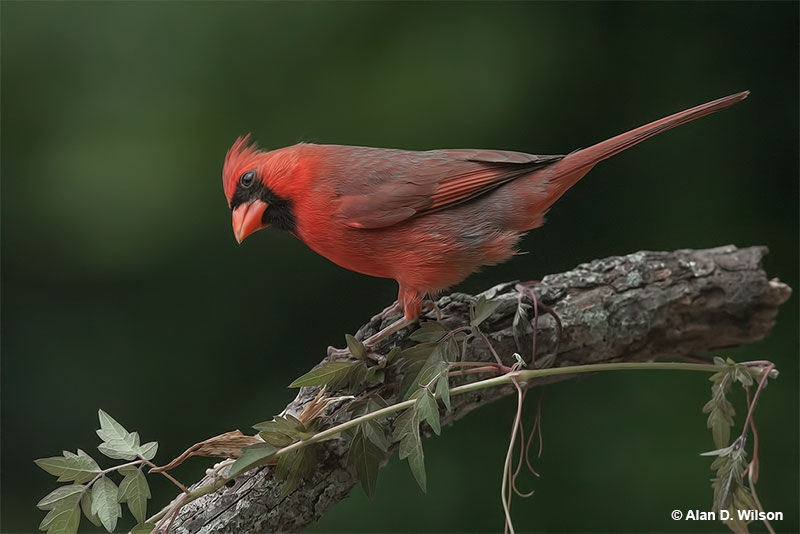
Scientific name: Cardinalis cardinalis
Length: 8.75 inches
Weight: 1.6 ounces
Wingspan: 12 inches
Song: “pichew-pichew-pichew, chew,chew,chew,chew,chew”
Northern Cardinals are medium-sized songbirds with a perky crest and big orange-red beak. Males are bright red with a black throat and face, and have dusky red on their back, wings, and tail.
Female Northern Cardinals are grayish-brown and buff with some black on their face and throat. They also have red highlights in their crest, wings, and long, rounded tail.
This species has short, rounded wings and seems to bounce up and down as they move through the air. In flight, Northern Cardinals also make sharp chip notes.
It eats seeds, insects, and some fruit and is a regular visitor to bird feeders. They forage on and near the ground but males sing from a prominent perch.
This beautiful bird occurs in pairs and nests in bushes and low trees. It is common in the eastern and southwestern USA, southern Ontario, and in Mexico.
Key Identifications:
- Crested bird with a conical orange-red beak and a black face. Males are red, females are grayish-brown and buff.
- Forages for seeds and insects on and near the ground.
- Makes a cup-shaped nest in bushes and low trees.
- Sings a clear, whistled song of repeated notes. They can sound like “cheer, cheer, chew, chew, chew, chew” or a quick “birdee,birdee,birdee,birdee,birdee“. They also make loud, sharp chip notes.
Northern Cardinals are one of the most beautiful common birds in most states, including New Hampshire. It’s no wonder seven different states chose it to be their official bird. Another fun fact about this species is that female Northern Cardinals also sing. They sing while sitting on the nest and may do so to tell their mates to bring food or warn them about predators.
White-breasted Nuthatch
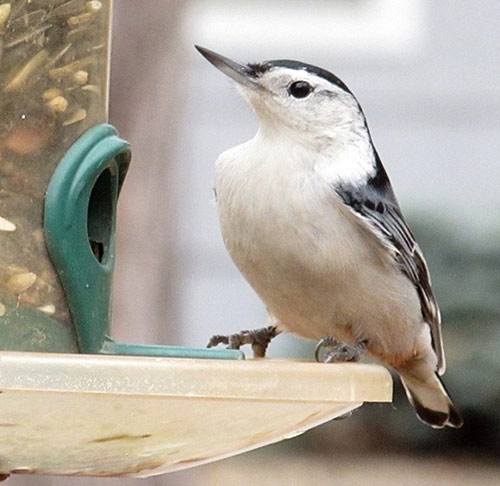
Scientific name: Sitta carolinensis
Length: 5.75 inches
Weight: .74 ounces
Wingspan: 11 inches
Song: “wehn wehn wehn wehn wehn wehn wehn wehn”
The White-breasted Nuthatch is a sparrow-sized bird with a longish, sharp, slightly upturned beak and a short black and white tail. It also has long wings, is mostly blue-gray above, and white and gray below with some chestnut on its belly and undertail.
Both sexes look similar and have a white face but males have a black cap and nape. Females have gray on their head and nape.
This small bird forages for insects, nuts, and seeds by creeping along branches and going down trunks, head-first. It uses its beak to pick food items from bark and also visits feeders.
The White-breasted Nuthatch makes a cup nest out of grass and soft bark inside a tree cavity or nest box.
White-breasted Nuthatches live in various wooded habitats in parts of southern Canada, most of the USA, and mountains in Mexico. They are frequent visitors to gardens near woodlands.
Key Identifications:
- Sparrow-sized, short-tailed songbird that is blue-gray above, mostly white below, and has a longish, slightly upturned beak.
- Creeps on branches and down tree trunks for insects, nuts, and seeds. Also visits feeders.
- Uses grass and soft bark to make a cup nest in a tree cavity or nest box.
- Quite vocal and makes nasal calls “yank yank”, and sings a nasal, laughter-like song, “wehn wehn wehn wehn wehn wehn wehn wehn”.
White-breasted Nuthatches are small blue-gray and white birds with slightly upturned beaks. They creep down trees in many wooded areas and are regular visitors to feeders. This species prefers to forage in flocks with chickadees and titmouse species because they are good at finding food and quick to make alarm calls when they see a predator.
Downy Woodpecker
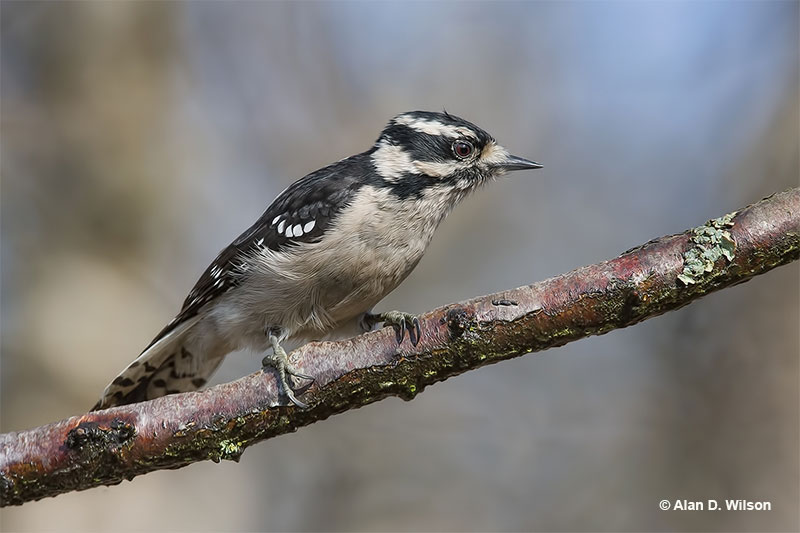
Scientific name: Dryobates pubescens
Length: 6.75 inches
Weight: .95 ounces
Wingspan: 12 inches
Song: “Pik! Ch,ch,ch,ch,ch,ch,ch!”
The Downy Woodpecker is a small black and white woodpecker with a short, black beak. They are patterned black and white above and have white backs and white underparts. Both sexes look alike except that males have a small, bright red patch on the top back part of their head.
Young birds look like adults but have a reddish patch on the top of their head. Downy Woodpeckers also have a few small black marks in their white outer tail feathers, and a small white tuft at the base of their beak.
This woodpecker eats insects, other small creatures, seeds, and small fruits. It pecks into live and dead wood and often forages on smaller branches and twigs. These friendly little woodpeckers are also common feeder birds.
They nest in tree cavities and live in gardens and a wide variety of woodlands. We see Downy Woodpeckers in much of Canada and the USA but not in arid habitats.
Key Identifications:
- Smallest woodpecker in North America. Mostly black and white with a short, black beak.
- Forages on trees, in bushes, and at feeders for insects, seeds, and suet.
- Nests in tree cavities.
- The Downy Woodpecker makes sharp “pik!” calls and also has a trilled call, “Ch,ch,ch,ch,ch,ch,ch!“.
Downy Woodpeckers are the smallest woodpecker species in North America and usually occur in pairs. They can also forage with other small birds and often visit feeders. This species takes advantage of its size to peck into the stems of weeds and other plants too small for larger woodpeckers to perch on.
Mourning Dove
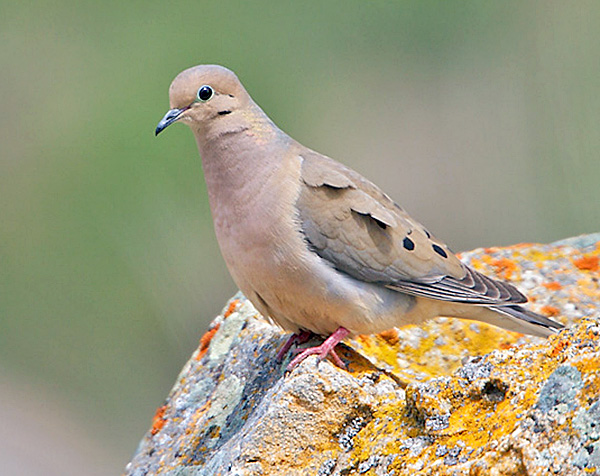
Photograph © Greg Lavaty.
Scientific name: Zenaida macroura
Length: 12 inches
Weight: 4.2 ounces
Wingspan: 18 inches
Song: “hooOOA, hoo, hoo, hoo”
Mourning Doves are medium-sized, grayish-brown doves with long tails. They have small black spots on their wings and a small head with a slender, dark beak.
Males and females also have narrow gray eyerings, a black mark on the face, and pale iridescent gold on the sides of their necks. They look alike except for males having more gray on the head and neck, and more iridescence.
This dove has fairly long wings and swift, direct flight. When flying, it shows black and white in its tail.
The Mourning Dove occurs in woodlands, gardens, on farms, and in urban areas. This common feeder visitor eats seeds and grains. It also forages in open situations, picking food from the ground.
This pleasant dove species can visit a feeder on its own or forage in small flocks. It builds an unkempt stick nest in bushes and trees and is very common throughout the USA, southern Canada, and Mexico.
Key Identifications:
- Plain brown and gray dove with a long, pointed tail.
- Feeds on seeds at feeders and on the ground in open areas.
- Makes a small, messy nest of sticks in trees.
- Sings a sad and owl-like “hooOOA, hoo, hoo, hoo”.
The Mourning Dove is the common garden dove in most of its range. It often visits feeders and its cooing song is commonly mistake for an owl. This species has a short lifespan with many adults only living for a couple of years or less.
Song Sparrow
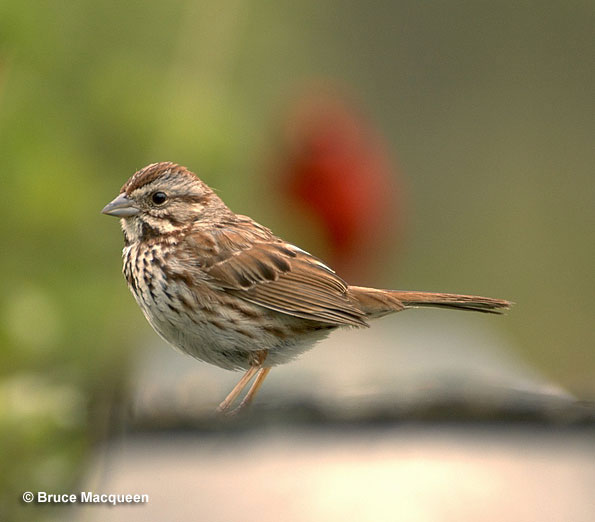
Scientific name: Melospiza melodia
Length: 6.25 inches
Weight: .7 ounces
Wingspan: 8.25 inches
Song: “seet serate sitsziziziziziziziz seet”
The Song Sparrow is a small, gray and brown, streaked songbird with a thick dark mark on each side of its white throat. Males and females look the same and have white underparts with a dark brown mark on their breast, and dark brown streaks on their breast and sides.
Most Song Sparrows also have two narrow wing bars and show a rounded tail when fluttering between bushes.
This species feeds on insects, seeds, and small fruits. Pairs forage by picking up food items on and near the ground. They are also frequent visitors to bird feeders.
Song Sparrows use grass, stems, hair, and other materials to make a cup nest placed on or near the ground. They nest in dense vegetation, shrubbery, or low trees, often near water.
This species uses a wide variety of brushy habitats in open and wooded situations in southern Alaska, most of Canada, and all of the USA.
Key Identifications:
- Small brown, streaked sparrow with a dark mark on its breast.
- Forages on and near the ground for seeds and insects in brushy habitats.
- Builds a cup nest on or near the ground in a shrub or low tree.
- Makes high-pitched “tink”, chirping calls, and has a cheerful song with a trill, “seet serate sitsziziziziziziziz seet”.
Song Sparrows are reddish-brown songbirds with dark brown streaks and a dark brown breast patch on white underparts. They usually occur in pairs and are often heard and seen in brushy areas and large gardens. There are several subspecies with distinct plumages including a large, dark one that lives on the Aleutian Islands.
Dark-eyed Junco
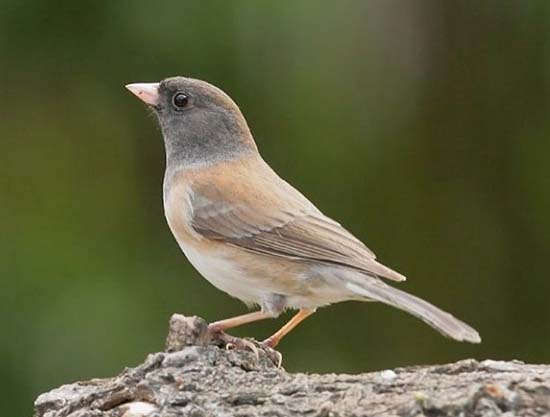
Scientific name: Junco hyemalis
Length: 6.25 inches
Weight: .67 ounces
Wingspan: 9.25 inches
Song: “sipsipsipsipsipsipsip”
Dark-eyed Juncos are sparrow-like birds with pale conical bills and dark eyes. This small bird has variable plumage with most being slate gray or gray and brown with white on their bellies, and white under their tails.
Other plumages include birds with dark masks and faint white wing bars, juncos with pale gray hoods and pinkish sides, and birds with blackish hoods and chestnut sides.
In flight, all Dark-eyed Juncos show extensive white in their longish tails.
This species feeds on seeds, insects, and some fruit and grain. Juncos forage on the ground in wooded areas, parks, and other habitats. They also feed on fallen seed beneath feeders.
They build cup nests on the ground under fallen logs, in roots, and other hidden spots. After breeding, juncos form flocks that forage together in similar wooded and semi-open habitats.
Dark-eyed Juncos are common birds in Canada, the USA, and parts of Mexico.
Key Identifications:
- Sparrow-like gray and brown bird with dark eyes, a pale beak, and white in the tail.
- Forages for seeds and insects on the ground, can feed on seeds at and beneath feeders.
- Builds a cup-shaped nest on the ground in tree roots, under logs, and other hidden places.
- This species often makes a sharp, high-pitched chip note, “pik!”. On breeding grounds, males sing a short, plain trill, “sipsipsipsipsipsipsip”.
Dark-eyed Juncos are sparrow-like, gray and brown birds with much white in the tail. Common wintering birds in many areas, they forage for seeds on the ground in wooded and park-like habitats. In many places, this common species is also known the “Snowbird” on account of only occurring in the winter months and having white on the belly and tail.
Hairy Woodpecker
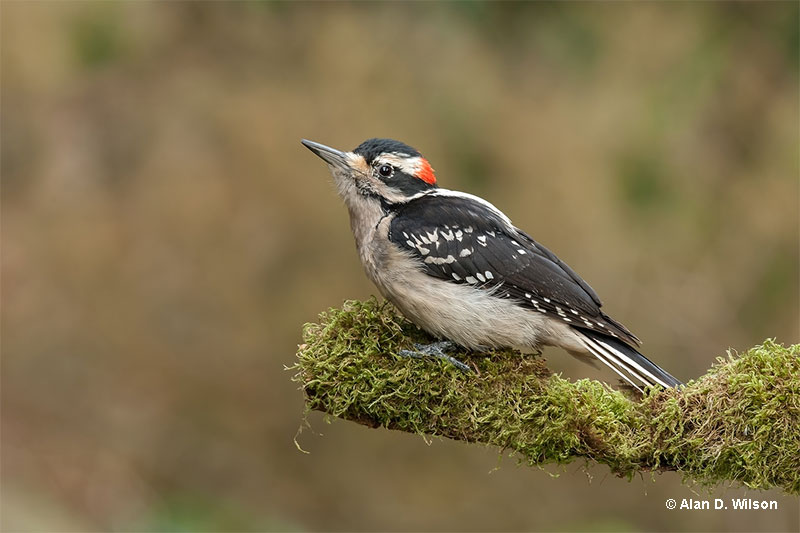
© Alan D. Wilson
Scientific name: Dryobates villosus
Length: 9.25 inches
Weight: 2.3 ounces
Wingspan: 15 inches
Song: “Qquechichichichichichicchichic!”
Hairy Woodpeckers are medium-sized, black and white woodpeckers with long, straight beaks. They have a white patch on their back and a black and white tail with unmarked, white outer tail feathers.
Both sexes look very similar but males have a small, bright red spot on the back of their head. Young birds have a dull red patch on top of their heads.
This woodpecker species feeds on insects, other small creatures, and a variety of seeds and fruit. They forage by pecking into bark and picking berries and other fruit from branches. In areas with big, mature trees, Hairy Woodpeckers are also regular visitors to bird feeders.
The Hairy Woodpecker nests in tree cavities. This species lives in parks and woodlands with mature trees in Alaska, much of Canada, and in most of the USA, including New Hampshire.
They are absent from southern Florida and arid parts of the American Southwest.
Key Identifications:
- Medium-sized, black and white woodpecker with a long straight beak and unmarked, white outer tail feathers.
- Picks insects and fruit from bark of big trees, also eats seeds at feeders.
- Nests in tree cavities.
- Often calls and gives a sharp and explosive, “Peek!” and a longer rattle, “Qquechichichichichichicchichic!”.
Hairy Woodpeckers are medium-sized, black and white woodpeckers with long, straight beaks. They need woodlands and parks with big trees and dominate the smaller Downy Woodpecker at feeders. This species gets its name from fine, hair-like feathers on its back.
Red-winged Blackbird
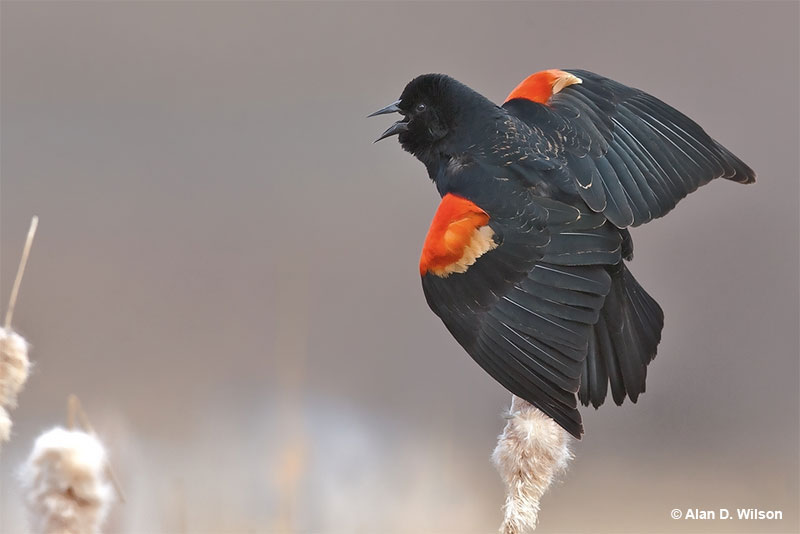
Scientific name: Agelaius phoeniceus
Length: 8.75 inches
Weight: 1.8 ounces
Wingspan: 13 inches
Song: “kan-keree!”
The Red-winged Blackbird is a medium-sized blackbird species with a sharp, all black bill. Males also have a scarlet patch with a pale yellow border on the shoulder of each wing.
Female Red-winged Blackbirds are dark, heavily streaked, brownish-gray birds with an orange-buff eyebrow and throat. She can also have a little bit of dingy red on her shoulder.
Red-winged Blackbirds often flock together and can form very large groups in the winter. They feed on seeds, grain, and insects found on lawns, in marshes, farm fields, and other open habitats.
This species builds a cup nest made of leaves and dead stems in a bush or other low vegetation in a marsh, park, or brushy field.
Red-winged Blackbirds are very common birds that live in all sorts of open habitats. We see them in parks, farming areas, and marshes in much of Canada, the USA, Mexico, and parts of the Central America.
Key Identifications:
- Males are medium-sized blackbirds with a bright red patch on their wings. Females are heavily streaked, have a sharp black beak, and buff on the head.
- Feeds on seeds, grain, and insects on the ground in many open habitats.
- Builds a cup nest in a bush or other low vegetation.
- Red-winged Blackbirds often call. Males sing a loud, “kan-keree!” and both sexes also make “check!” calls and a high-pitched whistle-like sound.
The Red-winged Blackbird is a common, social species easily seen in marshes and open habitats. In the winter, it can form huge flocks that feed in farm fields. This species can make a daily commute of 50 miles to and from roosting and feeding sites.
Gray Catbird
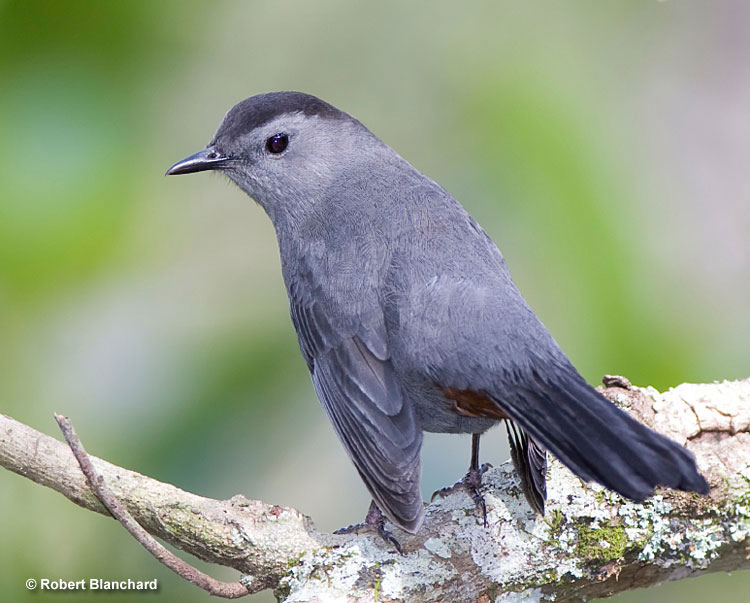
Scientific name: Dumatella carolinensis
Length: 8.5 inches
Weight: 1.3 ounces
Wingspan: 11 inches
Song: “rheah!”
The Gray Catbird is a slender, gray songbird with a black cap, and chestnut under its tail. Both sexes look alike and have beady, black eyes on a gray face, a longish tail, and a smallish, black beak.
This reclusive bird feeds on insects and berries in thickets and second growth. It forages by moving through dense vegetation and picking food items from leaves and twigs.
Gray Catbirds make bulky, open cup nests constructed with grass, strips of vegetation, and hair. They build their nests in shrubs, bushes, and small trees.
The Gray Catbird is often heard before it is seen, and loves to skulk in low thick vegetation. This migrant species spends summers in southern Canada, and in much of the eastern and northern USA. In fall, it migrates to coastal areas in the eastern and southern USA, and Florida south to northern South America.
Key Identifications:
- Small to medium-sized, slender gray bird with a black cap and chestnut under the tail.
- Feeds on insects and berries in low, dense vegetation.
- Builds a bulky cup nest in small trees and bushes.
- The Gray Catbird is quite vocal and often makes a cat-like mewing call, “rheah!”. It also has a melodious, complex song made of jumbled, chattering sounds and phrases.
Gray Catbirds are slender gray songbirds with a black cap and chestnut under the tail. Pairs forage for bugs and berries in dense second growth. Although they don’t mimic as many bird species as their mockingbird relatives, Gray Catbird songs include the sounds of some birds, frogs, and other noises.
Eastern Phoebe
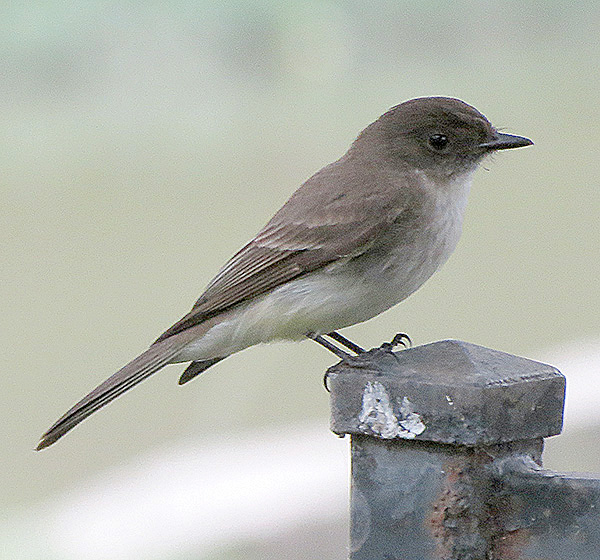
Photograph © Sam Crowe.
Scientific name: Sayornis phoebe
Length: 7 inches
Weight: .7 ounces
Wingspan: 10.5 inches
Song: “see-BEE! See BIDIT”
The Eastern Phoebe is a small to medium-sized, plain flycatcher that is dark, brownish gray above, and white below. It also has gray on its breast and a long, blackish tail constantly wagged up and down.
This bird also has a blackish head and some pale edging on long, dark wings. Males and females look alike but young birds have pale yellow bellies.
This flycatcher uses its slender beak to snap up insects. It catches them by flying from a perch and snatching them in flight, from foliage while hovering, and from the ground.
We usually see Eastern Phoebes on their own, sitting on low or medium-height perches. They make cup nests of mud, moss, and leaves on rocky outcrops, and under bridges and other structures.
This species breeds in woodlands and parks in Canada and the eastern USA, and winters in similar habitats the southeastern USA and Mexico.
Key Identifications:
- Plain, mid-sized flycatcher that is dark brownish-gray above and pale below with some gray on the breast.
- Perches low to mid-height in woodlands and flies out to catch insects. It also feeds on berries in winter.
- Makes a cup nest of mud and vegetation on structures and rocky outcrops.
- Sings a song that sounds like its name, “see-BEE! See BIDIT”.
The Eastern Phoebe is a featureless flycatcher with dark upperparts and pale underparts. It often wags its tail up and down and sallies from perches to catch insects. In 1804, this species became the first bird to be banded in North America when John James Audubon put silvered thread on an Eastern Phoebe’s leg.
House Finch
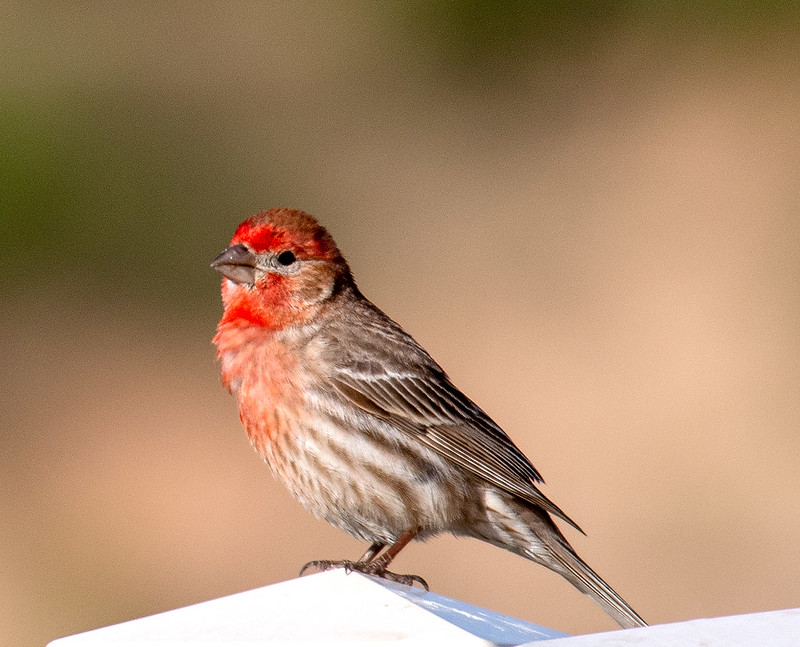
Photograph © John Hansen
Scientific name: Haemorhous mexicanus
Length: 6 inches
Weight: .88 ounces
Wingspan: 10 inches
Song: “chip,chip,chiprididip,ZREEYachip”
House Finches are sparrow-sized birds with dark, rounded beaks and fairly long wings. Males are orange-red or rose-red on their head, throat and breast, and have some red on their rump. They also have brownish streaks on their back, flanks, and white belly.
Like the male, female House Finches have two white wing bars on long, gray-brown wings. However, they lack red and are mostly streaked, dull brown-gray birds.
House Finches feed on seeds, buds, fruit, and flowers. They often visit feeders in New Hampshire but also forage on the ground, and in bushes and trees.
We see these pretty birds in deserts and arid zones, and in parks, farmland, urban areas, and other semi-open habitats.
The House Finch makes a soft cup nest built on a tree, building ledge or other spot with some overhanging cover. They often occur in small groups and live in southern Canada, most of the USA, Mexico, and Hawaii.
Key Identifications:
- Reddish or plain gray-brown, streaked, sparrow-like bird.
- Eats seeds, flowers, buds, and fruit. Can visit feeders but also forages on the ground and in bushes and trees.
- Makes a soft cup nest in trees, on building ledges, and other places.
- The House Finch often makes a soft, “fidip” call. Males also sing a warbling song from prominent, high perches. It sounds like, “chip,chip,chiprididip,ZREEYachip”.
House Finches are sparrow-like, reddish or brownish, streaked birds. They live in arid zones as well as in parks and urban areas. All of the millions of House Finches that live east of the Rocky Mountains are descendants of birds released on Long Island in 1939.
Canada Goose
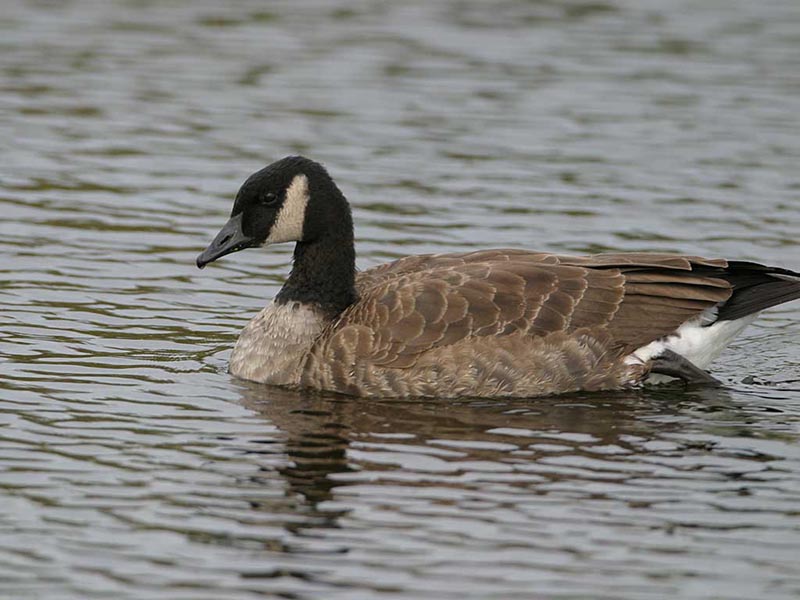
Scientific name: Branta canadensis
Length: 35 – 45.2 inches
Weight: 5.29 – 19.8 pounds
Wingspan: 50 – 67 inches
Song: “uurrRUNK! uurrRUNK!”
The Canada Goose is a large, grayish-brown bird with a long black neck, and black head with a white throat and cheeks. Males and females look alike and have pale barring, a white belly and undertail, and a short black and white tail.
They have strong direct flight and make deep flaps with long, broad wings.
Canada Geese feed on grass, sedges, and other vegetation, grain, and berries. They forage by walking along and grazing, or picking food from the ground and bushes. This species also feeds by dipping its head below the surface of shallow water.
This large goose uses grass and other plants to make a large, shallow cup nest on a small mound or other elevated spot next to water.
The Canada Goose prefers open grassy areas and farm fields near water where it can feed and see predators before they get too close. They live in Alaska, most of Canada, and most of the USA, being one of the most common birds of New Hampshire.
Key Identifications:
- Big, gray-brown goose with a long black neck, and black and white head.
- Grazes vegetation and forages for berries in wide open, grassy habitats near water like golf courses, parks, and airports.
- Makes a shallow, open cup nest on an elevated spot next to water.
- Vocal and often makes honking calls, “uurrRUNK! uurrRUNK!”.
Canada Geese are a large, common goose species with long black necks, and a black and white head. These big birds are a common sight on golf courses and other places that combine open lawns and water. When the Canada Goose and other birds migrate in “V” formation, they expend less energy than flying on their own.
Eastern Bluebird
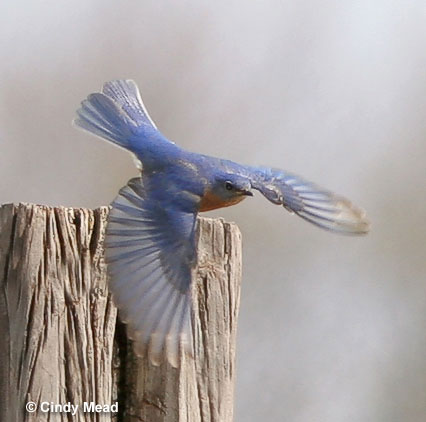
Scientific name: Sialia sialis
Length: 7 inches
Weight: 1.1 ounces
Wingspan: 13 inches
Song: “fer fer chidip fer”
The Eastern Bluebird is a rather small, blue and white bird with orange on the side of its neck, throat, breast, and flanks. The male has beautiful pastel blue upperparts, and a white belly and undertail.
Females have blue-gray upperparts, a broken white eyering, and some white on the throat.
Juveniles are gray-brown with some blue and pale spotting.
The Eastern Bluebird feeds on insects, fruit, and occasional seeds. It snatches insects in flight, picks them from leaves while hovering, and flies down to meadows and grassy areas to catch them on the ground.
Flocks of Eastern Bluebirds feed on small fruits by perching in fruiting trees and picking them from vegetation.
Eastern Bluebirds make a shallow cup nest out of grass inside a tree cavity or nest box.
This beautiful bird lives in open and semi-open habitats in southern Canada and the USA east of the Rocky Mountains. They also live in mountains in Mexico and northern Central America (including New Hampshire).
Key Identifications:
- Smallish blue and white bird with orange on their throat, breast, and flanks.
- Forages for insects and small fruit.
- Makes a shallow cup nest out of grass in a nest box or tree cavity.
- Has short melodious calls, “jeer” and a song of similar melodious notes, “cheweer chewit cherwit”.
The Eastern Bluebird is a smallish, blue and white thrush with orange highlights. They live in open and semi-open areas, and, in winter, form flocks that feed at fruiting trees. Eastern Bluebird populations have been boosted in many areas by “Bluebird Trails”; areas with nest boxes designed for this species.
Chipping Sparrow
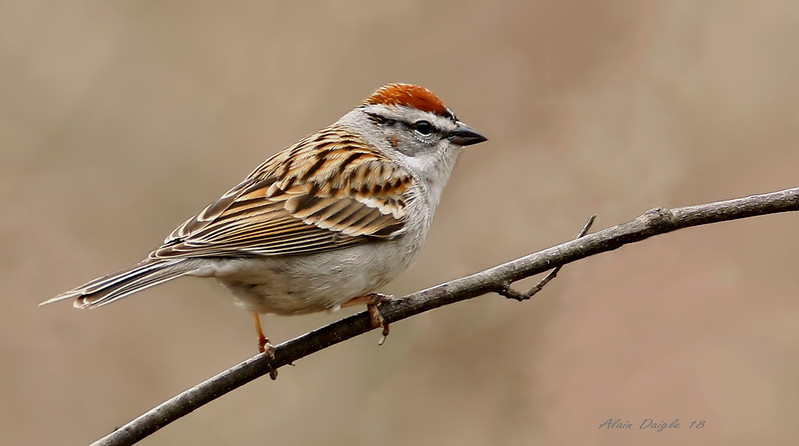
© Alain Daigle
Scientific name: Spizella passerina
Length: 5.5 inches
Weight: .42 ounces
Wingspan: 8.5 inches
Song: “titititititititititititti”
The Chipping Sparrow is a small, brown and gray sparrow with a longish, slightly forked tail and a conical bill. In summer, it has a rufous cap, white eyebrow, and dark line through each eye.
Males and females look the same and have small white crescents above and below the eyes, a pale brown back with dark streaks, gray rump and underparts, and pale brown wings with two pale wing bars.
In fall and winter, Chipping Sparrows are duller, have brown and buff heads, a gray rump, and a dark line through their eyes.
This species forages on the ground for insects and small seeds in open, grassy areas near conifers.
Chipping Sparrows use grass, hair, and other materials to make a cup nest low in a bush or small tree.
These sparrows live in parks, open woodlands, and on golf courses in much of Canada, most of the USA, and parts of Mexico.
Key Identifications:
- Small, slender sparrow with a rufous cap and white eyebrow in summer and a brown and buff head, gray rump, and dark line through their eyes in the winter.
- Forages for insects and seeds on the ground in grassy habitats with pines.
- Uses grass and animal hair to make an open cup nest low in a bush or small tree.
- Makes short chip notes and has a mechanical sounding, trilled song, “titititititititititititti”.
The Chipping Sparrow is a small and slender sparrow with a rufous cap and pale eyebrow. They are common birds of golf course and other similar, semi-open habitats and flock together during the winter. Chipping Sparrows eat more than 70 times their own weight in seeds, every winter!
Mallard
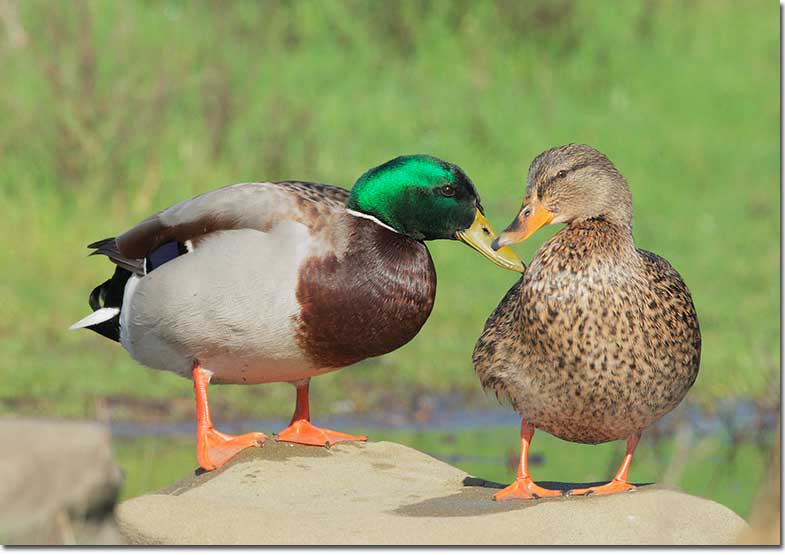
Mallard pair (Male and female)
Scientific name: Anas platyrhynchos
Length: 23 inches
Weight: 2.4 pounds
Wingspan: 35 inches
Song: “quack, quack”
The Mallard is a fairly large, familiar duck. The male has a metallic green head, yellow bill, narrow white ring around the neck, and chestnut breast. The rest of the bird is pale gray with pale brown, and black on its back and around his tail.
Female Mallards are mottled brown and buff with a dark crown and line through the eyes, and have a dark gray and orange beak.
In flight, both sexes show a green-blue wing patch bordered with white.
Mallards eat a variety of items including insect larvae, snails, other small aquatic creatures, acorns, seeds, and grain. They forage by filtering and picking up food items in and near shallow water, and in farm fields.
This New Hampshire duck species makes a shallow nest with sticks and lined with down feathers. It builds its nest on the ground, hidden in grass or under a bush.
The Mallard lives in ponds, marshes, and many wetland habitats in Canada, USA, and Eurasia.
Key Identifications:
- Feeds on insect larvae, grain, seeds, and other items picked up with its bill in and near shallow water.
- Makes a shallow stick nest hidden in grass or under a bush.
- The female Mallard makes the classic “quack, quack” duck sound. Males make similar but softer sounds and a whistling call.
The Mallard is a fairly large and familiar duck with a dark green head (the male), or is buff and brown with a dark gray and orange beak (the female). Thus duck species often lives near people and occurs on lakes, ponds, and other wetlands. No matter how different they look, most small domestic duck species are descended from wild Mallards.
Red-eyed Vireo
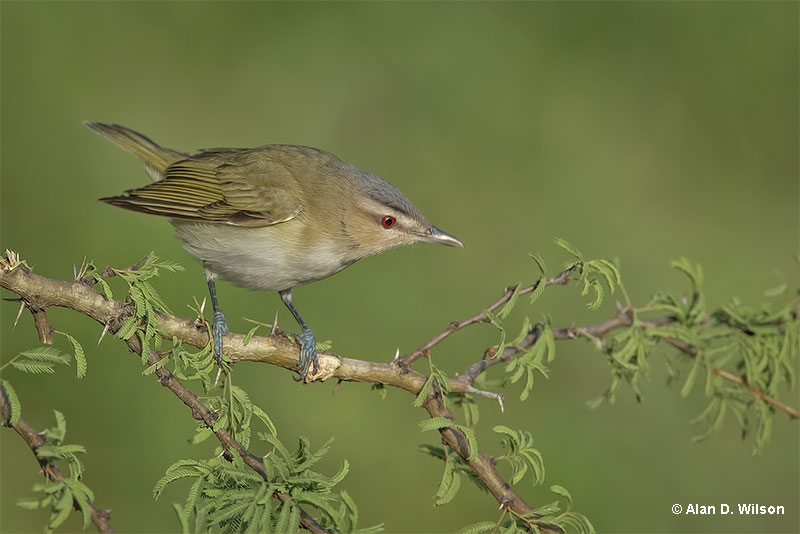
Scientific name: Vireo olivaceus
Length: 6 inches
Weight: .6 ounces
Wingspan: 10 inches
Song: “See me? Up here! Here I am…See me?”
The Red-eyed Vireo is a small, pale bird that is olive above and white below. Both sexes are similar and have a gray crown with a narrow black border separating it from its white eyebrow.
It also has a dark line through its reddish eyes, a grayish beak with a small hooked tip, and some pale yellow under its tail.
Red-eyed Vireos feed on caterpillars and insects. They forage by steadily moving through leafy vegetation and then picking food items from leaves and twigs. They also eat berries in the fall and on their wintering grounds.
This species builds a small cup nest out of lichen, small twigs, and other plant matter. The female usually constructs the nest high in a deciduous tree.
The Red-eyed Vireo breeds in forest habitats in Canada, and the northern and eastern USA, and winters in tropical forests habitats in the Amazon basin.
Key Identifications:
- Small, pale bird with a gray crown that is olive above, white below, and has a dark line through its reddish eyes.
- Makes a small cup nest our of twigs, lichen, and other plant matter high in a tree.
- The male Red-eyed Vireo constantly sings, “See me? Up here! Here I am…See me?”. When alarmed, Red-eyed Vireos also make harsh, rasping calls.
The Red-eyed Vireo is a small olive and white bird with a gray crown and a dark line through its reddish eyes. This small bird breeds in forest habitats with tall, leafy trees. According to Guinness World Records, this species has the record for most number of songs in a given time for any bird species; 22,197 songs over 10 hours!
Red-bellied Woodpecker
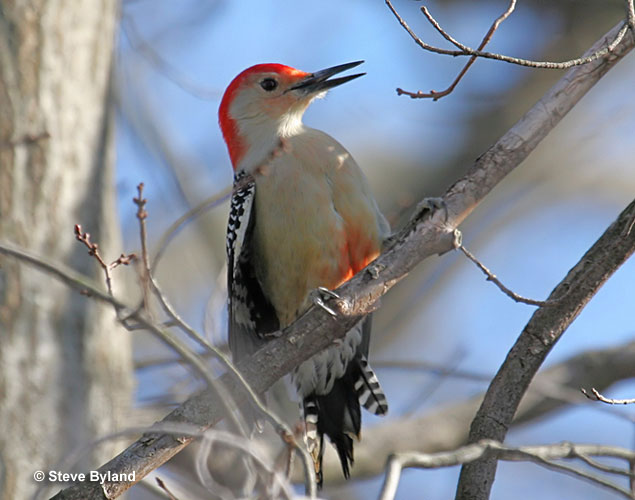
Scientific name: Melanerpes carolinus
Length: 9.25 inches
Weight: 2.2 ounces
Wingspan: 16 inches
Song: “Qwerr!”
Red-bellied Woodpeckers are medium-sized with black and white barring on their back and wings. They have a long beak and pale gray underparts with a small red patch on the belly.
Males have red on the head from the bill to the back of the neck (the nape). Females have an orange-red spot above their bill and red on the back of their head. Both sexes have a mostly white rump and central tail feathers.
This woodpecker species has long wings and “undulating” flight where it moves up and down as it flies. In flight, Red-bellied Woodpeckers show a small white patch in their wings.
The Red-bellied Woodpecker lives in wooded habitats. It eats nuts, seeds, insects, fruit, and can attack nestlings of other species. It also visits bird feeders.
This striking woodpecker occurs in pairs and nests in tree cavities high above the ground. It is common in the eastern USA and parts of southern Ontario.
Key Identifications:
- Grayish woodpecker with black and white barring above, and red on the top of the head and back of the neck.
- Forages for seeds, nuts, insects and other food on trunks and branches.
- Nests in a tree cavity, high overhead.
- Makes a loud exclamation, “Qwerr!“. It also makes other, briefer and quieter “chug” calls.
Red-bellied Woodpeckers are common and adaptable birds. As long as big trees are present, we see them in urban areas as well as wilder places. They also visit feeders and have a very long tongue. When extended, it sticks out 2 inches past the tip of its bill!
Red-breasted Nuthatch

© Elaine R. Wilson
Scientific name: Sitta canadensis
Length: 4.5 inches
Weight: .35 ounces
Wingspan: 8.5 inches
Song: “yeank, yeank, yeank”
The Red-breasted Nuthatch is a small, warbler-sized bird with a dark gray, straight or slightly upturned beak, gray upperparts, and reddish-orange underparts. It also has a black cap, a white face with a narrow black mask, and black and white in its short tail.
Males and females are similar except that females are paler and have a gray cap.
Red-breasted Nuthatches eat insects during the summer and conifer seeds in the winter. These small, animated birds forage by creeping down coniferous tree trunks and on branches. They use their bills to probe bark and pick out insects and seeds.
This species excavates a tree cavity and makes an open nest of bark and other vegetation.
The Red-breasted Nuthatch lives in coniferous and mixed forests in southern Alaska, Canada, and the western and northern USA. They also breed in the Appalachians and can be seen in most of the USA in winter.
Key Identifications:
- Small, short-tailed bird with a narrow white eyebrow, black mask, gray upperparts, and reddish-orange underparts.
- Creeps along tree trunks and branches to forage for insects and conifer seeds.
- Nests in tree cavities.
- The distinctive nasal call of the Red-breasted Nuthatch, “yeank, yeank, yeank”, is a good way to find this bird.
The Red-breasted Nuthatch is a small, short-tailed bird with black and white on its head, gray upperparts, and reddish-orange underparts. It usually occurs alone and lives in coniferous woods and trees. To protect its nest, this species puts sticky pine resin around the border of its nesting hole.
White-throated Sparrow
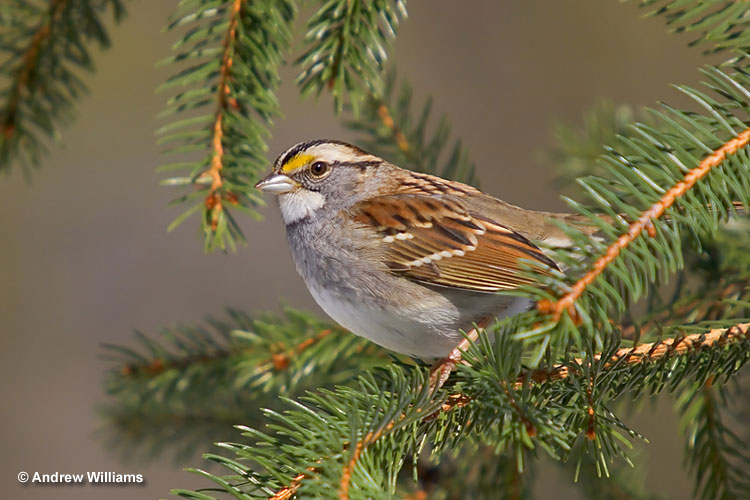
Scientific name: Zonotrichia albicollis
Length: 6.75 inches
Weight: .91 ounces
Wingspan: 9 inches
Song: “Ohhh Canada Canada Canada”
The White-throated Sparrow is a chunky, gray and brown sparrow with a white throat, and black and white stripes on its head. It has dark streaks on its back, a gray rump, and a bit of yellow in front of its eyes.
Males and females look the same and have reddish-brown wings with two white wing bars. Young White-throated Sparrows and some adults are duller brown with tan stripes on their heads and a dingy white throat.
White-throated Sparrows forage for seeds and insects on the ground, and also eat fruits in short trees and bushes. They reveal hidden food items by using their feet to scratch and kick away leaves.
This sparrow breeds in northern forests and builds a cup nest with grass and twigs. They construct the nest at the edge of forest, on or close to the ground, in dense vegetation.
These sparrows usually occur in flocks and winter in the eastern and southwestern USA and parts of California.
Key Identifications:
- Large sparrow with a white throat and bold black and white or tan stripes on its head.
- Scratches leaves on the ground to find seeds and insects. They also eat berries.
- Makes a cup nest of grass, bark, and twigs, on the ground, under dense vegetation.
- Flocks of White-throated Sparrows often make sharp “tink” calls. They also sing a clear, whistled song, “Ohhh Canada Canada Canada” or, “Ohhh, Cana, Cana, Cana”.
White-throated Sparrows breed in northern forests and flock together during the winter in various woodland habitats. The yellow pigment in the patches in front of their eyes comes from eating colorful berries during fall and winter.
European Starling
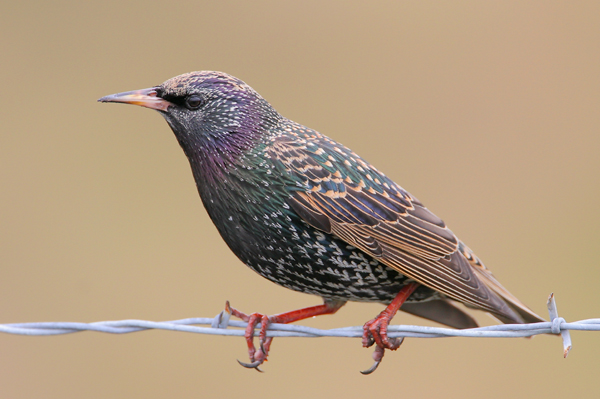
Photograph © Greg Lavaty.
Scientific name: Sturnus vulgaris
Length: 8.5 inches
Weight: 2.9 ounces
Wingspan: 16 inches
Song: “tiktiktitZHREEree..tiktiktik..ZHREE”
European Starlings are plump, short-tailed birds with long sharp beaks and longish, pointed wings. In summer, they have yellow beaks, glossy black plumage with purple and green highlights, and some small white spots.
Males and females are similar but males have less spotting and glossier plumage. In winter, they have black beaks, white spots, and more reddish colors in their wings.
Young starlings are shaped like adults but are grayish birds with a dark beak and a pale throat.
This species feeds on a variety of insects, fruit, and seeds. They can dominate bird feeders and are common species in urban areas, parks, farmlands, and other open habitats.
This European Starling builds a soft cup nest in a tree cavity, nest box, or suitable cavity in other structures.
European Starlings flock with each other and blackbird species, especially during the winter. They live across a large part of Canada and the USA.
Key Identifications:
- Rotund, short-tailed bird with a long, sharp beak, and pointed wings. Glossy black with some spotting in the summer and blackish with heavy white spotting and streaking in the winter.
- Feeds on seeds, fruit, and insects. Visits feeders and forages on the ground in flocks.
- Builds a soft cup nest in nest boxes and other cavities.
- The European Starling makes a wide variety of mechanical and whistled sounds. They also mimic other birds and sounds in their environment. They sing long, jumbled mechanical-sounding songs, “tiktiktitZHREEree..tiktiktik..ZHREE”.
European Starlings are rounded, blackish birds with long, sharp beaks and short tails. They live in towns, cities, parks, on farms, and in other open habitats. This species forms large flocks called, “murmurations” that move in coordinated patterns.
Common Raven
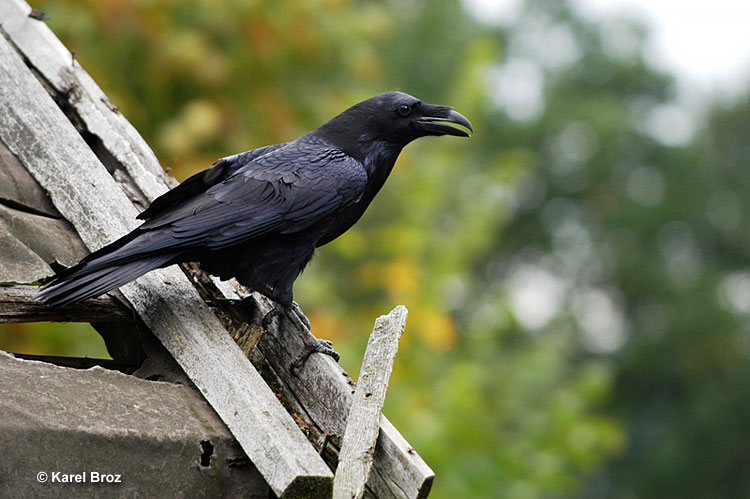
Scientific name: Corvus corax
Length: 24 inches
Weight: 2.6 pounds
Wingspan: 53 inches
Song: “Grauk Grauk Grauk Grauk!”
The Common Raven is a big, black crow-like bird with long, broad wings and a broad, wedge-shaped tail.
Both sexes look alike and have feathers extending onto the top part of their strong, stout beaks.
This bird is often seen in soaring flight or in direct flight where it gives a few strong flaps between glides.
Common Ravens are omnivores that feed on carrion, small animals, nesting birds, and various other food items. They forage by flying above roads and other places and are always on the lookout for feeding opportunities.
This big Corvid makes a big, bulky nest out of sticks and lines the shallow cup with mud, wool, and other items. It builds its nest on a cliff, tree, bridge, or other structure.
The Common Raven lives in wilderness areas from the Arctic to parts of the northeastern USA and the western USA. In some places, it lives in urban areas. Common Ravens are common in New Hampshire.
Key Identifications:
- Huge, black, crow-like bird with a strong, stout beak and a wedge-shaped tail.
- An omnivore that feeds on small animals, carrion, and other food items.
- Makes a big bulky stick nest in trees, on cliffs, and on human-made structures.
- Common Ravens are vocal birds. One of their most common calls is a load and croaking, “Grauk Grauk Grauk Grauk!”.
The Common Raven is a large, black, crow-like bird of mountains, forest, tundra, and other wild areas. Some also live near people and, in flight, they can sometimes be mistaken for raptors. However, no hawk species is entirely black with a wedge-shaped tail. The Common Raven can mimic human speech and is one of the most intelligent bird species.
FAQ
How many bird species are native to New Hampshire?
In total, 425 bird species are native to New Hampshire. This is the number of bird species that have been documented in the state.
What is the most common bird in New Hampshire?
The most common bird in New Hampshire is the Black-capped Chickadee. According to breeding bird surveys in New Hampshire and sightings on the eBird platform, this species is seen more than any other bird in the state.
What is the state bird of New Hampshire?
New Hapshire’s state bird is the beautiful Purple Finch. This bird was chosen to represent the state in 1957.
What is the largest bird in New Hampshire?
The largest bird in NH is the American White Pelican. This rare visitor is 62 inches long, weighs 16.4 pounds, and has a 9 foot wingspan! Another large bird species is the Mute Swan. This huge bird is 60 inches long, has an 80 inch wingspan, and weighs 23 pounds.
What is the smallest bird in New Hampshire?
The smallest bird in NH is the Calliope Hummingbird. This rare vagrant is 3.25 inches long and weighs .1 ounces.
What are the loud birds in New Hampshire?
The loud birds in New Hampshire could be American Crows, Blue Jays, and Northern Flickers. All of these bird species have loud voices, are very vocal, and are common birds of New Hampshire.
Let us know, which of these have you seen?

